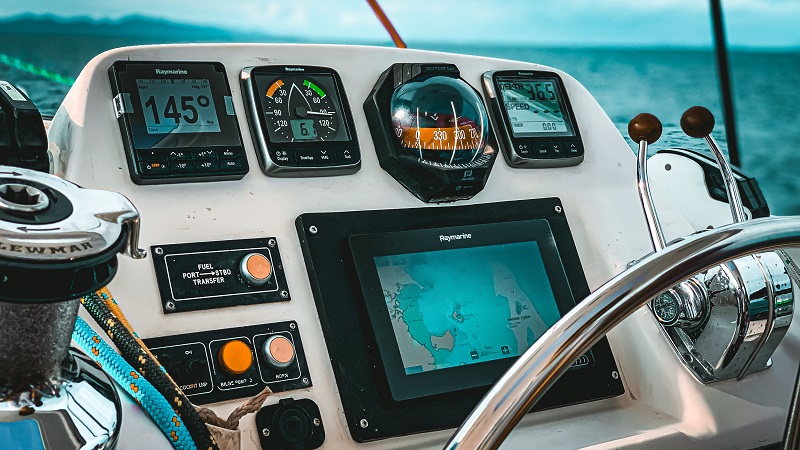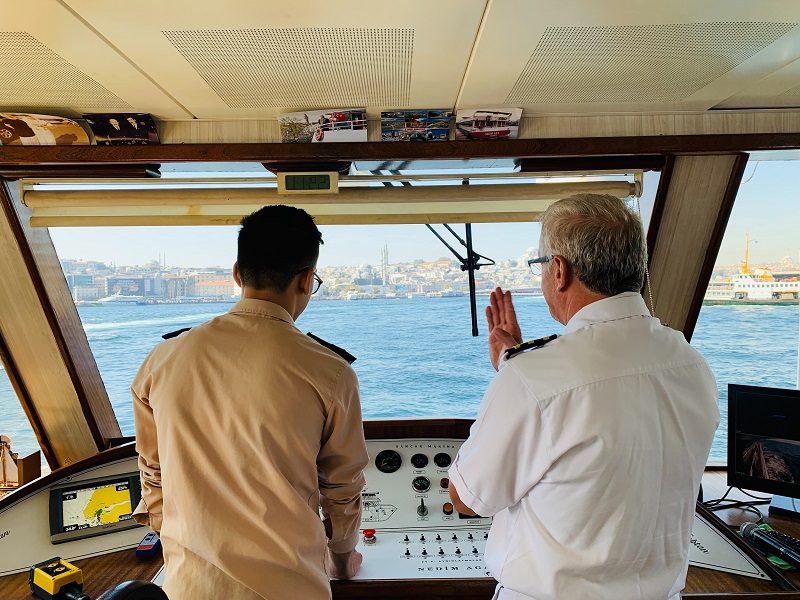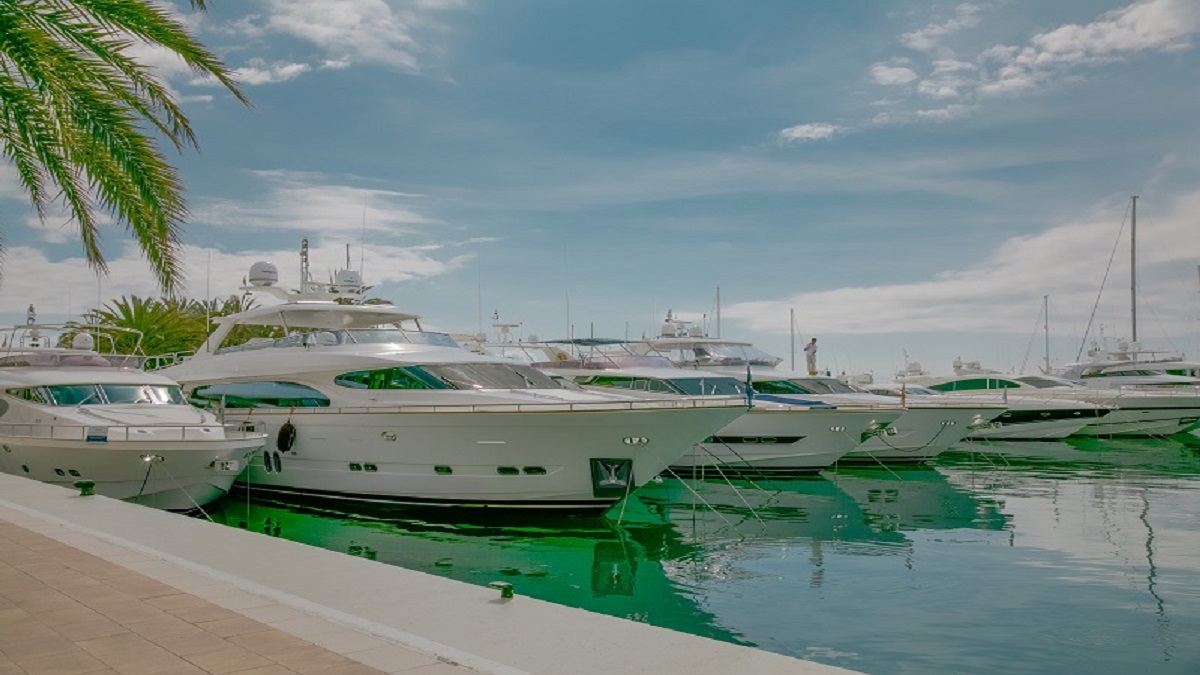Getting your yacht from one port to another isn’t always as easy as it sounds. A short coastal hop is no problem when your full-time crew is around, but even moving your boat a short distance to a haul-out or refit without skilled help can be an ordeal.
Yacht deliveries run the gamut of a few miles down the coast for service or storage, to offshore international deliveries crossing thousands of miles in a journey of several weeks. No matter what your yacht moving needs, a few elements of the delivery are always the same.
What is a Yacht Delivery?


The simplest definition of a yacht delivery is moving a boat from port to port without the owner on board. With a permanent crew, that happens all the time, and owners will fly to the new location to enjoy the change of scenario without giving it much thought.
But what we’re talking about is a little different – moving a boat without the regular captain and crew, or some combination of the regular staff who run the boat. For smaller yachts without permanent crews, a delivery is often done when an owner doesn’t feel they have the time, experience, or help needed to move the boat on their own.
The key point is that the boat is transported without the direct involvement of the ownership or even the owner’s permanent representatives being in charge of the vessel.
Why is a yacht delivery needed?
There are many reasons a yacht may need delivery. Ocean passages and long offshore trips can be arduous and unpleasant, and the owner of a large yacht may not have the interest, inclination, or time for those trips. Most large yachts are bought for pleasure, and taking a yacht on a long voyage is far from a relaxing experience for some owners and passengers.
Reasons for doing a delivery include:
- Seasonal changes of location or storage. Many yachts winter in the tropics but return to North America, Europe, or other cooler climes in the summer months. This annual relocation may not involve the regular crew, especially if they are local, seasonal employees.
- New yachts. Getting a new yacht from the builder to the owner’s home waters can be a major task. Unless the owner has already arranged a permanent crew, it will need to be sailed on its own bottom if it is too big to ship, or shipping is prohibitive.
- Permanent or seasonal changes cruising grounds. Taking a yacht from cruising the Caribbean to the South Pacific or a similar shift in cruising venue may need a delivery team.
- Refitting. Most shipyards aren’t in glamourous places that yacht owners like to go for vacations, so getting a boat there is often a delivery task.
- Moving the yacht when there is no captain. Captains resign and move on, an owner takes some time to find a new captain for a new boat, or a replacement for a departure. In the meantime, the yacht needs to move.
- Moving a yacht owned by an inexperienced owner. This is a very common application for smaller yachts with owner/operators. Insurers are fine with inexperienced owners in protected waterways, but moving a boat from the Chesapeake to the Caribbean? A captain and crew with offshore experience may be the only way.
Yacht Delivery or Shipment?
Everything from smaller yachts to some super yachts can be shipped. But are they better traveling on their own bottoms? The answer depends on the destinations, distances, and timing of the delivery. And the owner’s budget.
Yacht Shipping
Yacht shipping services run from major ports around the world on an annual schedule. The good news is that you can put your yacht on a ship in Auckland, NZ and pick it up in Miami, FL. Or from many locations around the world throughout the year. They will cradle up your yacht and secure it for sea, and get it to her new port on schedule.
But shipping schedules are fixed in advance, and space is limited. Larger yachts require considerable bespoke cradling and preparation, so the costs can be quite high.
The other downside to shipment is that it is still from shipping port to shipping port. If you want your yacht in Maine or Majorca but you can only get it shipped to Ft. Lauderdale, FL or Genoa, Italy, you’re still going to have a delivery on the end. It’s a shorter one, and skips the big ocean passage. But someone is going to have to take delivery of the yacht when it’s unloaded and get it where it’s needed.
There are advantages. Fuel capacity doesn’t limit your delivery range, for example. It can be faster, much faster with sailing yachts. And there’s less risk to the yacht when it’s on a bigger ship.
Shipping vs. Delivering
Yacht deliveries have the enormous advantage of being from where the yacht is currently to exactly where you want it to go, when you want it to go, and subject only to the limitations of weather and safety. The yacht won’t have to be stripped and packed on a ship, and delivery is often less expensive.
But it’s not without costs. You must hire and feed crew, fuel the vessel, and insurance for the delivery may be extra. Sea time also puts wear and tear on the yacht, and equipment and systems may break and need repair. It may also take more time to get your boat delivered on her own bottom, since commercial shipping is comparatively fast in most cases, especially compared to sailing yachts.
A yacht delivery service gives you control
The chief advantage of a delivery is the control over destinations. You’re not tied to a larger ship’s itinerary, and you can get the boat where you need it, when you need it.
A professional yacht delivery service will tailor the delivery to your needs for schedule and destination, which is something you can not do on a larger ship. They will know captains and crew, and bring much logistical expertise to the planning, preparation, and execution of your delivery.
How do yachts get delivered?

No matter the crew or service you use, the delivery process is similar. The goal is a safe, timely delivery of the boat without excessive costs or risk to the yacht or the crew.
First, you determine your itinerary and schedule – where you want the boat and by what date. When you do this, it’s important to consider the practical realities of ocean sailing, how your boat sails, and that you may know a lot less about getting your boat between ports than your delivery captain. So your initial ideas will need adjustment once the planning begins.
The next step is to find your delivery captain or service, and plan with them how best to do the delivery. The captain should know if they need help, what the best time of the year is, and what routes are best or your yacht’s capabilities.
Your yacht will need to be prepared for an offshore passage, and many delivery teams do with this. They will also inspect the yacht and make recommendations for safety and reliability. Some crews will manage getting the recommendations done, and there will be a last check before departure.
The captain and crew will do the delivery on the best weather window during the planned departure time, and bring the boat in safely and tidied up at the destination.
As part of the delivery, you will need to get your captain and crew to your boat, and fly them home once the delivery is done, cover their expenses, and pay for all your boat’s expenses along the way.
Freelance captain and crew
There are many freelance captains and crew out there who may offer to deliver your boat. And there are many competent captains doing this. But not everyone is as they present themselves.
It’s important that you properly vet any independent captain and crew you hire. You are entrusting a very expensive asset to a comparative stranger, and you won’t likely be on board to see that your yacht is being cared for to your standards.
Before you hire a captain, do:
- Review their resume and experience. They should have experience with vessels similar to yours, and making similar deliveries. You don’t want a coastal delivery skipper making his first blue water delivery on your yacht.
- Check credentials. Not all licenses and credentials are created equal, and you should be sure that any licenses or credentials are current and proper.
- Check references. Don’t skip this sometimes uncomfortable step, because it’s your best source of information that the captain you’re considering can really do the job.
Some captains will want to bring their own crew along, and this can be an excellent idea since a competent captain will also know a good crew. Make sure you do the same checking into any crew the captain recommends.
Read also: CAN OWNING A YACHT TO CHARTER (REALLY) BE PROFITABLE?
Yacht delivery services – specialists with professional delivery teams
A yacht delivery service is a business that focuses full-time on delivering yachts. They will have a roster of experienced captains and crew and will organize the delivery for you. While they are also often dealing with freelance independent captains and crew, the difference is they properly vet anyone for you, and they work with captains they know.
A full service delivery specialist will know all the details to attend to that you, as an owner, may not. This is an enormous advantage to you, as it takes much of the organizational headache away.
What is the crew usually needed to perform a yacht delivery?

The crew needed will vary with the size of the vessel, of course. But it also is affected by the length of the journey in miles, how much time it will take, and how it will be sailed. For example, a coast-wise journey with stops in port every night takes longer, but requires fewer crew members because you won’t need a twenty-four hour watch for most of the trip.
The Captain – the key to success
The delivery captain manages the delivery from start to finish, setting the course and departure window, watch schedules and rotations, and making decisions in the face of bad weather and other problems.
If the delivery is across an ocean, a captain with offshore experience is a must. Coastal deliveries don’t have quite the same issues, but you still need experience and skill.
For smaller yachts, look for a USCG Master’s License or RYA Yachtmaster Ocean rating, and experience with a boat at least as large as yours. Larger yachts and super yachts should find a qualified captain with appropriate licensing for the size of your vessel.
You will relinquish complete control of your yacht to the captain, so you need to be assured he or she is up to the task.
Mates
Skilled mates can stand watch on their own and have the experience to know when it’s time to bring the captain in on decisions. For longer or nonstop passages, you may need or the captain may insist upon one or more additional crew members. More experienced, senior delivery crew may cost you more.
Engineers
If a yacht requires an engineer during regular operations, you should have one on board for deliveries. Smaller yachts will not need one, but it can be very important for the more complex engines on larger vessels, unless the delivery crew already has significant engineering experience.
The deck team
Deck crew will help stand watch on larger vessels, and clean the yacht up when it arrives. For larger vessels and longer passages, deck crew can be an extra help to get the yacht there safely.
The galley team
If you need a big delivery team, a galley specialist makes the delivery more comfortable and safer. Hot, timely meals keep a crew performing at peak safety and efficiency.
Read also: Yacht crew positions : Hierarchy, Missions & Salaries explained
How much does it cost to deliver a yacht?

The delivery costs for a yacht vary with the size of the vessel, the length of the delivery, and the type of delivery. Delivering a yacht from Maine to Florida down the U.S. East coast is similar in length to taking a boat from Hampton, Virginia, to the Caribbean. But one is a series of mostly day trips with overnight stops, and the other is a single, long offshore passage. The costs will be very different.
You hire most crew on a day rate, and that coupled with delivery time is the largest determinant of delivery cost. Typical day rates for captain and crew vary with skill and the type of trip. In the example above, the daily rate charged for a coastal captain running 10-12 hours per day and pulling into a marina may be lower than the charge for a nonstop, twenty-four-hour day trip by a skilled blue water captain.
A captain can cost from $250 to $600 per day, while mates, engineers, galley, and crew can run from $200-$400 depending on skill and experience.
Besides sea time, all captain and crew are paid the day rate for travel time, preparation time, days spent working on the boat, waiting for weather windows, or otherwise involved with the delivery. Depending on the readiness of the yacht, the captain and a few crew may have many days of work preparing the boat for delivery.
Besides crew pay, the owner will cover:
- Flights to the boat and back home for the captain and crew
- A per diem for food and lodging, unless food and lodging is provided on board the vessel.
Other delivery related expenses the owner will cover include:
- Fuel
- Dockage before and after the delivery, and any marinas stopped in along the way. This is common for coastal deliveries.
- Transit, clearance, and port charges.
- Any supplies, parts, repairs, or equipment needed to make the yacht ready for delivery.
Other delivery related expenses the owner will cover include:
Every delivery is unique, and the final price can be affected by everything from weather to mechanical breakdowns. All those details should be in the Delivery Contract, with specifics like the rights of the captain to halt or pause the trip for safety, and how costs are handled.
Yacht delivery companies will give you an estimate or quote based on your tailored circumstances, but a fixed price arrangement is unusual, but not impossible.
Read also: IS BUYING A BOAT A BAD IDEA?
FAQ
Yes, they can. In fact, with many smaller yachts, the owner may accompany the paid captain to get the sea time and learn more about their boat and offshore sailing.
Larger yachts can take pleasure passengers, but they should be aware of the requirements and limitations during a delivery. Galley crew and stewards should also be on board.
Absolutely, those are some of the most common deliveries. Many owners don’t have the time or the skill to move their yachts such long distances, so they will have them delivered.
Long distance deliveries are significantly more complex and expensive than local trips. Depending on the yacht’s capabilities, only certain types of trips and routes may be possible, or only certain times of year. They may also need special equipment and additional crew to stand watches.
For example, crossing the 3,000 mile stretch of ocean from the Galapagos to French Polynesia may be a problem for power vessels with limited range, so you may need supplemental fuel tanks. Or sailing yachts may have to sail different, longer routes to avoid adverse wind directions at the wrong time of year, like sailing upwind from New Zealand to Tahiti in the trades.
To be a delivery captain takes years of experience handling a variety of boats over many miles of water. Amateur sailors can transition to professional delivery crew or even a captain over time, but it will take some work. Being a delivery captain is a genuine job, with real required skills and certifications.
At a minimum, you would need several offshore passages, and sufficient sea time to qualify for and pass the USCG Masters License or a RYA Yachtmaster Ocean certification. These credentials require verified sea time and experience.
There are ways for enthusiastic but inexperienced sailors to get the required experience, as volunteer crew on yacht deliveries, and crew for cruising yachts on ocean passages. Some delivery skippers may take unpaid crew who are looking for sea time, though you’d probably be on your own getting to the boat and back. You would get an excellent experience.
Many full-time cruising couples also pick up volunteer crew for large passages, and that’s another way to get your sea time.
Starting your professional journey
Deliveries are a good way to build up offshore experience, fast. If you’ve got training and experience, you can start crewing and learning to build your skills. And those skills will serve you well, building a full-time career in the yachting industry as a permanent crew or full-time delivery captain.
Read also: How much Should you Expect to Tip on a Yacht Charter? Everything you Should Know




